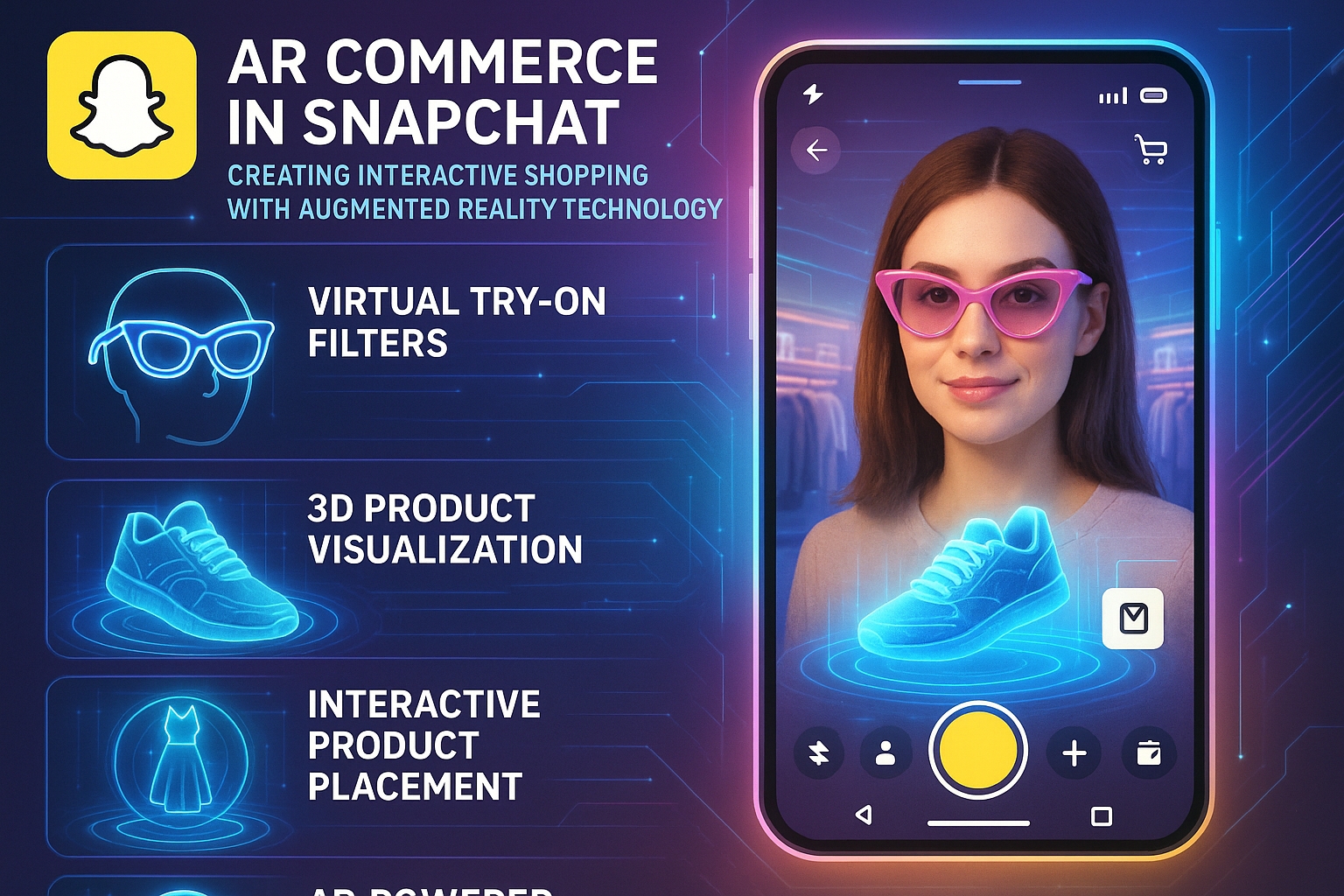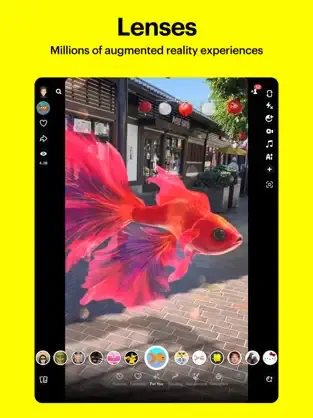AR Commerce in Snapchat: Creating Interactive Shopping with Augmented Reality Technology

The convergence of augmented reality and social commerce has fundamentally transformed how consumers interact with brands and make purchasing decisions. Snapchat, as a pioneer in AR technology integration within social platforms, has evolved far beyond its origins as a messaging application to become a sophisticated commerce platform that bridges the gap between digital discovery and physical purchase experiences. The platform’s AR commerce ecosystem represents a paradigm shift from traditional static product displays to immersive, interactive shopping environments that allow consumers to visualize, try, and experience products before making purchase decisions.
Snapchat’s approach to AR commerce differs significantly from conventional e-commerce strategies by leveraging the platform’s core strengths in camera technology, real-time rendering, and user engagement. Unlike traditional online shopping experiences that rely on static images and written descriptions, Snapchat’s AR commerce creates three-dimensional, interactive product experiences that respond to user movements, environmental conditions, and personal preferences. This technology enables brands to present their products in contextually relevant ways, allowing customers to see how items will look in their actual living spaces, on their bodies, or integrated into their daily routines.
The platform’s AR commerce infrastructure is built on sophisticated computer vision algorithms, machine learning models, and real-time 3D rendering capabilities that work seamlessly across millions of diverse mobile devices. These technological foundations enable brands to create shopping experiences that feel natural and intuitive while providing unprecedented levels of product interaction and customization. The result is a shopping environment where the boundary between digital and physical retail experiences becomes increasingly blurred, creating opportunities for brands to engage customers in ways that were previously impossible through traditional digital channels.
The Architecture of AR Commerce Technology
Understanding the technical foundations of Snapchat’s AR commerce system requires examining the multiple layers of technology that work together to create seamless shopping experiences. The platform’s AR engine processes camera input in real-time, identifying surfaces, objects, and user features to anchor virtual products accurately within the physical environment. This spatial understanding enables virtual products to behave realistically, casting shadows, reflecting environmental lighting, and maintaining proper scale relationships with surrounding objects.
The rendering pipeline optimizes performance across diverse hardware configurations while maintaining visual quality that meets consumer expectations for product representation. Advanced texture mapping, material simulation, and lighting calculations ensure that virtual products appear authentic and appealing within the AR environment. The system dynamically adjusts rendering quality based on device capabilities, ensuring consistent experiences across different smartphone models and performance levels.
Machine learning algorithms continuously improve tracking accuracy and object recognition capabilities, learning from millions of user interactions to enhance the precision of virtual product placement and behavior. These improvements compound over time, making AR shopping experiences increasingly sophisticated and reliable. The platform’s cloud-based processing capabilities supplement on-device computation, enabling complex AR effects that would otherwise be impossible on mobile hardware alone.

Strategic Implementation of AR Shopping Experiences
Creating effective AR commerce experiences requires strategic thinking that goes beyond simply placing virtual products in camera views. Successful implementations begin with understanding customer journey mapping and identifying the specific moments where AR technology can provide the most value in the decision-making process. These moments often occur when customers need to visualize size, fit, style compatibility, or spatial relationships that traditional product photography cannot adequately convey.
The most successful AR shopping campaigns integrate seamlessly with existing brand narratives and customer touchpoints, creating cohesive experiences that feel natural rather than gimmicky. This integration requires careful consideration of brand voice, visual identity, and user experience principles that maintain consistency across all customer interactions. The AR experience should enhance rather than replace traditional product information, providing additional context and confidence that supports purchase decisions.
Timing and context play crucial roles in AR commerce effectiveness. The technology works best when introduced at moments when customers are actively considering purchases rather than during casual browsing sessions. Understanding user intent and designing AR experiences that align with customer needs at specific points in the purchase funnel significantly improves engagement rates and conversion outcomes.
Personalization capabilities within AR experiences create opportunities for brands to tailor product presentations to individual customer preferences, purchase history, and demographic characteristics. These customizations can include product recommendations, size suggestions, color variations, and complementary item suggestions that enhance the shopping experience while increasing average order values. The key lies in making personalization feel helpful rather than intrusive, providing value that customers recognize and appreciate.
Advanced Lens Studio Development Techniques
Lens Studio serves as the primary development environment for creating sophisticated AR shopping experiences, offering tools and capabilities that enable brands to build interactive product demonstrations, virtual try-ons, and immersive brand environments. The platform’s visual scripting system allows creators to develop complex interactions without extensive programming knowledge, while advanced scripting capabilities provide flexibility for custom functionality and integration with external systems.
Creating effective product visualization requires careful attention to 3D model optimization, ensuring that digital products render smoothly while maintaining visual fidelity that accurately represents physical items. This optimization process involves texture compression, polygon reduction, and level-of-detail systems that maintain performance across different device capabilities. The goal is achieving the highest possible visual quality while ensuring smooth frame rates and responsive interactions.
Lighting and material systems within Lens Studio enable realistic product presentation that adapts to various environmental conditions. Advanced material shaders can simulate different textures, reflectivity levels, and surface properties that help virtual products appear authentic within real-world environments. Understanding how different materials behave under various lighting conditions is essential for creating convincing AR shopping experiences.
Interactive elements within AR lenses can include gesture recognition, touch controls, voice commands, and environmental triggers that respond to user actions and environmental changes. These interactions should feel intuitive and provide clear feedback to users, helping them understand how to engage with virtual products effectively. The design of these interactions significantly impacts user satisfaction and the likelihood of successful purchase outcomes.
Integration capabilities allow AR lenses to connect with external databases, inventory systems, and e-commerce platforms, enabling real-time product information, pricing updates, and direct purchase pathways. These integrations create seamless transitions from AR exploration to actual purchase transactions, reducing friction in the conversion process and improving overall shopping experience quality.
Product Catalog Integration and Management
Effective AR commerce implementation requires sophisticated product catalog management that maintains consistency between virtual representations and physical products. This process begins with high-quality 3D asset creation that accurates captures product dimensions, materials, colors, and functionality. Professional 3D scanning, photogrammetry, or computer-aided design modeling ensures that virtual products maintain fidelity to their physical counterparts across all viewing angles and interaction scenarios.
Dynamic product catalogs enable real-time updates to pricing, availability, specifications, and promotional information within AR experiences. This capability ensures that customers always see current information while interacting with virtual products, preventing disappointment and confusion that can occur when AR experiences become outdated. Integration with inventory management systems allows AR experiences to reflect actual product availability, preventing customers from engaging with products that are out of stock.
Variant management becomes particularly important in AR commerce, as customers often want to explore different colors, sizes, styles, and configurations within the same AR session. Efficient variant switching capabilities allow users to compare options directly within the AR environment, facilitating decision-making and reducing the need to navigate between multiple product pages or applications.
Metadata association enables AR experiences to carry rich product information including materials, care instructions, sizing guides, customer reviews, and related product recommendations. This information can be presented contextually within the AR experience, providing customers with comprehensive product knowledge without interrupting the immersive shopping experience.
Quality assurance processes ensure that all virtual products meet visual and functional standards before deployment. This includes testing across different devices, lighting conditions, and use scenarios to verify that AR experiences perform consistently and meet customer expectations. Regular auditing and updating of AR assets maintains long-term experience quality as technology capabilities evolve.
Conversion Optimization Through AR Analytics
Measuring the effectiveness of AR commerce experiences requires sophisticated analytics that go beyond traditional e-commerce metrics to capture the unique interactions and behaviors that occur within augmented reality environments. Understanding how customers engage with virtual products, where they focus their attention, and how long they spend exploring different product features provides insights that can inform optimization strategies and improve conversion rates.
Spatial analytics track user interaction patterns within AR environments, revealing which product angles, features, and configurations generate the most engagement. This information helps brands optimize product presentations, highlighting the most compelling aspects while de-emphasizing less effective elements. Heat mapping of user attention within AR experiences identifies optimal placement for calls-to-action, product information, and interactive elements.
Session duration and engagement depth metrics indicate the level of customer interest and the effectiveness of AR experiences in maintaining attention. Longer engagement times typically correlate with higher purchase intent, making these metrics valuable predictors of conversion likelihood. Understanding the relationship between engagement patterns and purchase outcomes enables brands to identify and replicate the most effective AR experience elements.
Conversion funnel analysis within AR experiences reveals where customers typically drop off in the shopping process and identifies opportunities for improvement. This analysis might show that customers engage extensively with virtual products but struggle with the transition to purchase, indicating the need for smoother checkout integration. Alternatively, low initial engagement might suggest that AR experiences need better discovery mechanisms or more compelling entry points.
A/B testing capabilities within AR experiences allow brands to experiment with different product presentations, interaction methods, and conversion pathways to identify the most effective approaches. These tests might compare different virtual product arrangements, alternative interaction designs, or various call-to-action placements to determine which variations produce the best outcomes.
| AR Commerce Metric Category | Key Performance Indicators | Optimization Applications |
| Engagement Metrics | Session duration, interaction frequency, feature exploration depth | Content optimization, user experience refinement |
| Conversion Metrics | AR-to-purchase rate, cart addition rate, checkout completion | Funnel optimization, barrier identification |
| Retention Metrics | Return session rate, brand recall, social sharing | Long-term engagement strategies, viral coefficient improvement |
Cross-Platform Integration Strategies
Modern AR commerce success requires seamless integration across multiple touchpoints and platforms, creating consistent experiences that support customers throughout their entire shopping journey. This integration extends beyond Snapchat to include websites, mobile applications, physical retail locations, and other social media platforms where customers might encounter brand messaging and product information.
Website integration allows AR experiences initiated on Snapchat to continue seamlessly when customers visit brand websites for additional information or to complete purchases. This continuity might include transferring product configurations, saving explored items, or providing personalized recommendations based on AR interaction history. The goal is eliminating friction and maintaining context as customers move between different platforms and touchpoints.
Mobile application integration enables deeper customization and more sophisticated AR experiences that leverage additional device capabilities and user data. Native mobile applications can provide more complex AR functionality, offline capabilities, and integration with device-specific features like advanced camera systems or haptic feedback. The relationship between Snapchat AR experiences and dedicated brand applications should be complementary rather than competitive.
Physical retail integration creates opportunities for omnichannel experiences that bridge digital and in-store shopping. AR experiences can help customers locate products in physical stores, access additional product information while shopping in person, or compare in-store items with online alternatives. This integration enhances rather than replaces traditional retail experiences, adding value for customers who prefer multi-channel shopping approaches.
Customer relationship management integration ensures that AR interaction data contributes to comprehensive customer profiles that inform marketing strategies, product recommendations, and personalized experiences across all touchpoints. This data integration provides brands with holistic views of customer preferences and behaviors that extend beyond individual platform interactions.
Social media integration beyond Snapchat allows AR experiences to reach customers wherever they spend time online, creating multiple entry points for product discovery and engagement. Cross-platform AR campaigns can maintain consistent messaging while adapting to the unique characteristics and user behaviors of different social media environments.
Advanced Personalization and AI Integration
Artificial intelligence capabilities within Snapchat’s AR commerce platform enable sophisticated personalization that adapts shopping experiences to individual customer preferences, behaviors, and characteristics. Machine learning algorithms analyze user interactions, purchase history, demographic information, and contextual factors to create tailored product recommendations and customized AR experiences that feel personally relevant rather than generically promotional.
Computer vision algorithms can analyze customer features, style preferences, and environmental contexts to suggest products that are likely to appeal to individual users. For fashion and beauty brands, this might include recommending colors that complement skin tones, suggesting sizes based on body measurements, or identifying style preferences based on previous product interactions and purchases.
Predictive analytics capabilities help brands anticipate customer needs and present relevant products at optimal moments in the shopping journey. These predictions might be based on seasonal patterns, life events, previous purchase cycles, or expressed preferences that indicate future needs. The key is providing helpful suggestions that feel serendipitous rather than intrusive or overly aggressive.
Dynamic content adaptation ensures that AR experiences remain fresh and engaging for repeat visitors by rotating product presentations, introducing new features, and highlighting different product aspects based on previous interaction patterns. This adaptation helps maintain long-term customer engagement while providing reasons for customers to return to AR experiences multiple times.
Contextual awareness capabilities allow AR experiences to adapt to environmental factors such as location, time of day, weather conditions, or social contexts that might influence product relevance and presentation. A home decor brand might emphasize cozy, warm products during winter months while highlighting bright, energetic items during spring and summer seasons.
Future-Proofing AR Commerce Strategies
The rapid evolution of AR technology, consumer behavior, and mobile device capabilities requires forward-thinking approaches that anticipate future developments while maximizing current opportunities. Understanding technology trends, consumer adoption patterns, and competitive landscape developments enables brands to make strategic decisions that provide long-term value rather than short-term gains.
Hardware advancement trends indicate increasing AR capabilities in consumer devices, including improved cameras, more powerful processors, better displays, and potentially dedicated AR hardware. These developments will enable more sophisticated AR commerce experiences with higher visual quality, more complex interactions, and better performance across a wider range of devices. Brands should design AR strategies that can scale with these technological improvements.
Platform evolution considerations include anticipating new features, capabilities, and integration opportunities that Snapchat and other AR platforms will introduce. Staying informed about platform roadmaps and beta features allows brands to plan for future capabilities and potentially gain early adopter advantages through timely implementation of new technologies.
Consumer behavior evolution reflects changing expectations and comfort levels with AR technology as it becomes more mainstream. Understanding these behavioral shifts helps brands adjust their AR commerce strategies to align with evolving customer preferences and usage patterns. Early AR commerce experiences may need more explanation and guidance, while future experiences can assume greater user familiarity and expertise.
Competitive landscape monitoring ensures that AR commerce strategies remain differentiated and compelling as more brands adopt similar technologies. The goal is maintaining competitive advantages through innovation, superior execution, or unique value propositions that set brands apart in increasingly crowded AR commerce environments.
| Technology Evolution Factor | Current State | Future Implications | Strategic Considerations |
| Device Capabilities | Mid-range AR performance | High-end AR becoming standard | Design for scalability |
| User Adoption | Early mainstream adoption | Mass market acceptance | Reduce onboarding complexity |
| Platform Features | Basic commerce integration | Advanced AI and personalization | Prepare for enhanced capabilities |
Return on Investment Measurement and Optimization
Calculating return on investment for AR commerce initiatives requires comprehensive measurement frameworks that capture both direct financial impacts and broader brand value creation. Traditional e-commerce metrics provide starting points, but AR commerce success extends beyond immediate sales to include brand engagement, customer satisfaction, reduced return rates, and long-term customer relationship improvements.
Direct revenue attribution tracks sales that result from AR commerce interactions, measuring conversion rates, average order values, and customer lifetime value improvements associated with AR shopping experiences. These metrics provide clear financial justification for AR commerce investments while identifying the most valuable customer segments and interaction types.
Cost reduction benefits include decreased return rates when customers have better product understanding through AR experiences, reduced customer service inquiries when AR provides comprehensive product information, and improved inventory management when AR data reveals customer preferences and demand patterns. These indirect benefits often represent significant value that may not be immediately apparent in traditional ROI calculations.
Brand value enhancement through AR commerce includes improved brand perception, increased customer loyalty, enhanced differentiation from competitors, and positive word-of-mouth marketing that results from innovative shopping experiences. While these benefits may be harder to quantify directly, they contribute significantly to long-term business success and market positioning.
Customer acquisition efficiency improvements occur when AR commerce experiences reduce the cost of attracting and converting new customers through improved engagement rates, higher conversion rates, and increased organic sharing of AR experiences. Understanding these efficiency gains helps justify AR commerce investments and optimize marketing spend allocation.
Long-term strategic value includes the data insights, customer relationship improvements, and technology capabilities that AR commerce initiatives provide beyond immediate financial returns. These strategic benefits position brands for future opportunities and competitive advantages that may be difficult to quantify but represent significant business value.
The implementation of AR commerce within Snapchat represents a fundamental shift in how brands can engage with customers and facilitate purchase decisions. Success in this environment requires understanding the technology’s capabilities, strategic thinking about customer needs and behaviors, and careful attention to execution details that create seamless, valuable experiences for customers. As AR technology continues to evolve and consumer adoption increases, brands that master these capabilities will gain significant competitive advantages in the increasingly digital retail landscape. The future of commerce lies not in replacing traditional shopping experiences but in enhancing them with technologies that provide additional value, convenience, and engagement that meets the evolving expectations of digital-native consumers.
 snap-chat
snap-chat
